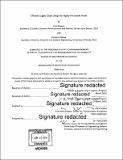Efficient supply chain design for highly-perishable foods
Author(s)
Khamsi, Cyril; Stolear, Veronica
DownloadFull printable version (10.50Mb)
Other Contributors
Massachusetts Institute of Technology. Engineering Systems Division.
Advisor
Chris Caplice.
Terms of use
Metadata
Show full item recordAbstract
To be competitive, businesses must make supply network design decisions, but often with only limited information and under uncertain conditions. How can an organization understand trade-offs between supply network decisions, without relying on complex, black-box models that require extensive data collection and hidden assumptions? We apply approximation methods to estimate and compare total logistics cost of supply network designs under various business conditions, such as variations in demand, changing costs, and shifting production policies. The method is applied to the real-world example of XYZ Co, evaluating network design choices for a new, rapidly growing product category: fresh foods. The method is used to evaluate tradeoffs between five distinct network designs for supply of these highly perishable foods to XYZ Co stores from a sole regional supplier. The model provides insights to help understand tradeoffs and key cost drivers, thereby channeling subsequent, more intensive and time- consuming analysis.
Description
Thesis: M. Eng. in Logistics, Massachusetts Institute of Technology, Supply Chain Management Program, 2016. Cataloged from PDF version of thesis. Includes bibliographical references (pages 52-53).
Date issued
2016Department
Massachusetts Institute of Technology. Supply Chain Management ProgramPublisher
Massachusetts Institute of Technology
Keywords
Supply Chain Management Program., Engineering Systems Division.